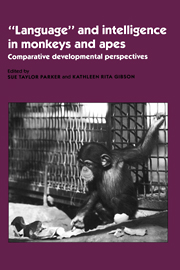Book contents
- Frontmatter
- Contents
- List of contributors
- Foreword
- Preface
- Acknowledgments
- Part I Theoretical frameworks for comparative developmental studies
- Part II Comparative developmental perspectives on cebus intelligence
- Part III Questions regarding imitation, “language,” and cultural transmission in apes and monkeys
- Part IV Developmental perspectives on social intelligence and communication in great apes
- 12 The emergence of intentional communication as a problem-solving strategy in the gorilla
- 13 “Social tool use” by free-ranging orangutans: A Piagetian and developmental perspective on the manipulation of an animate object
- 14 The development of peer social interaction in infant chimpanzees: Comparative social, Piagetian, and brain perspectives
- 15 Spatial expression of social relationships among captive Pan paniscus: Ontogenetic and phylogenetic implications
- Part V Development of numerical and classificatory abilities in chimpanzees and other vertebrates
- Part VI Comparative developmental perspectives on ape “language”
- Index
13 - “Social tool use” by free-ranging orangutans: A Piagetian and developmental perspective on the manipulation of an animate object
Published online by Cambridge University Press: 11 May 2010
- Frontmatter
- Contents
- List of contributors
- Foreword
- Preface
- Acknowledgments
- Part I Theoretical frameworks for comparative developmental studies
- Part II Comparative developmental perspectives on cebus intelligence
- Part III Questions regarding imitation, “language,” and cultural transmission in apes and monkeys
- Part IV Developmental perspectives on social intelligence and communication in great apes
- 12 The emergence of intentional communication as a problem-solving strategy in the gorilla
- 13 “Social tool use” by free-ranging orangutans: A Piagetian and developmental perspective on the manipulation of an animate object
- 14 The development of peer social interaction in infant chimpanzees: Comparative social, Piagetian, and brain perspectives
- 15 Spatial expression of social relationships among captive Pan paniscus: Ontogenetic and phylogenetic implications
- Part V Development of numerical and classificatory abilities in chimpanzees and other vertebrates
- Part VI Comparative developmental perspectives on ape “language”
- Index
Summary
Introduction
Primates explore their world in large part through the manipulation of objects. Object manipulation is of particular interest to psychologists because it is often linked with practical intelligence. Intellectual structures develop through interaction of one's actions on the environment and the maturing of the nervous system (Piaget, 1952, 1954). In fact, cognitive development of children during the first 2 years of life, as described by Piaget, is highly correlated with patterns of maturation in cortical function (Gibson, 1977, 1981). The flexibility and complexity of an individual's actions on the environment may also be indicators of intelligence (Lethmate, 1982; Maple, 1980; Menzel, Davenport, & Rogers, 1970; Parker, 1974). Furthermore, “an evolutionary connection may be assumed between the rise of intelligence and extensive manipulativeness” (Lethmate, 1982, p. 59).
Application of Piagetian theory
Piaget has shown that the manner in which young children interact with and explore their environment “can serve as a ‘window’ on cognitive development” (Belsky & Most, 1981, p. 630). The application of Piaget's theory to the study of nonhuman primates seems particularly appropriate for the following reasons:
Piaget provided an observational methodology that can be applied to nonhuman primates.
Piagetian theory is developmental and, as such, is applicable to describing development in other species.
Piagetian perspectives have contributed considerable organization to discrete data relevant to intelligence.
Because of the high degree of genetic relatedness (King & Wilson, 1975), the biological basis of the Piagetian perspective allows for meaningful comparisons of development and intelligence among the great apes, and between the great apes and humans.
- Type
- Chapter
- Information
- 'Language' and Intelligence in Monkeys and ApesComparative Developmental Perspectives, pp. 356 - 378Publisher: Cambridge University PressPrint publication year: 1990
- 23
- Cited by

